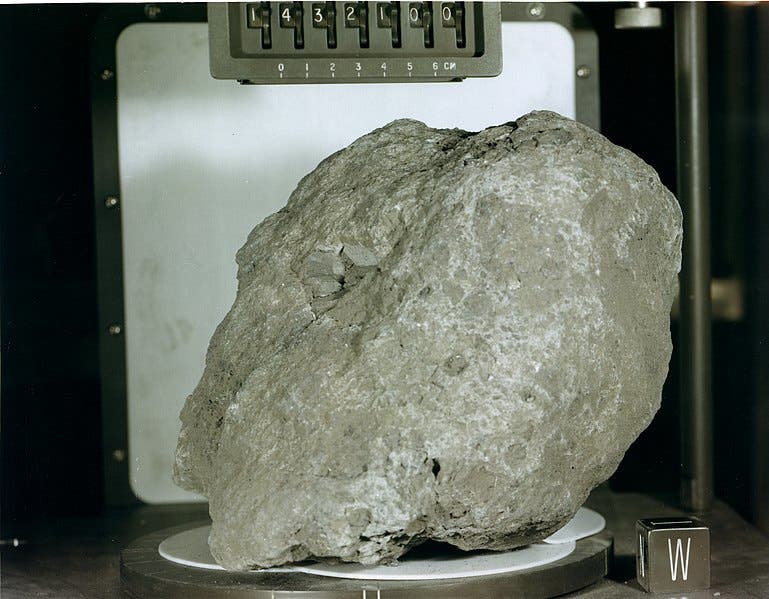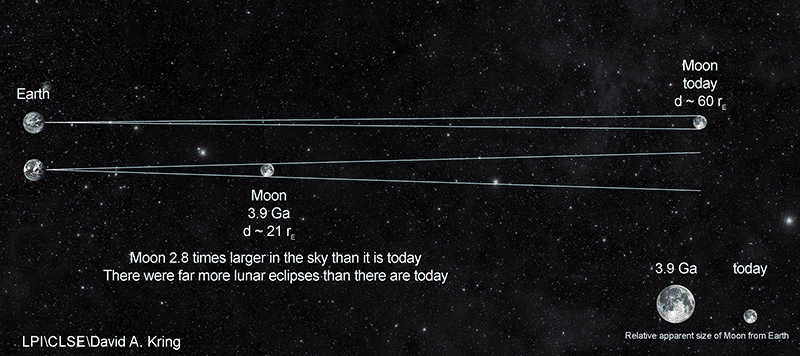In 1971, Apollo 14 astronauts brought home various minerals and rock samples from their brief lunar voyage. For decades, these lunar rocks have stayed in storage, occasionally being revisited by researchers curious to try out a new technique in order to learn more about the moon’s geochemistry. Imagine the surprise when scientists found in 2019 that one such rock was terrestrial in origin — to top it all off, it may very well be Earth’s oldest rock found thus far.

This adventurous moon rock has quite the backstory. According to an international team of researchers, the two-gram piece of quartz, feldspar, and zircon was found embedded in a larger rock called Big Bertha. This combination of minerals shouldn’t be found on the moon but they’re quite common here on Earth. Quartz and zircon form in oxidized systems such as Earth, in high temperature and pressure environments experienced deep below the planet’s crust.
Since zircon contains uranium, whose half-life is predictable, the international team of researchers were able to confidently date the rock to about 4 to 4.1 billion years ago, corresponding to the Hadean Eon of Earth’s geological history. They also determined — based on the sample’s geochemical properties — that it must have formed at a depth of about 20 kilometers (12.4 miles) beneath Earth’s surface.

So, how did it end up on the moon? The most plausible explanation is that a massive asteroid impact hurled this traveling mineral into space and eventually crashed into Earth’s natural satellite, which happened to look a lot different than we know it.
For starters, the moon was about three times closer to Earth than it is today. Around 4 billion years ago, the planet was regularly bombarded by cosmic objects of all shapes and sizes, some responsible for producing craters thousands of kilometers in diameter on Earth — so the impactor hypothesis isn’t that far-fetched of an explanation at all. Once on the moon, the rock was further sculpted by new impacts which melted and altered it into a new kind of rock about 3.9 billion years ago. These forces also buried it deep below the lunar surface.

The rock probably stayed buried for eons until around 26 million years ago when another asteroid impact, this time on the moon, produced the 340-meter wide Cone Crater. Finally, Apollo 14 astronauts found the rock and reunited it with mother Earth.
“It is an extraordinary find that helps paint a better picture of early Earth and the bombardment that modified our planet during the dawn of life,” said Dr. David Kring, co-author of the new study and a researcher at the Lunar and Planetary Institute (LPI).
This may all sound a bit ridiculous, but this is the most plausible explanation. For the minerals to have formed on the moon, Science Alert writes that they must have formed 30 to 70 kilometers below the surface, in an “unusually oxidizing magmatic environment with oxygen levels much higher than those in the lunar mantle 4 billion years ago.” Theoretically, the fragment may have formed in weirdly water-rich pockets of magma deep within the ancient moon but it seems much more likely that the rock formed within our planet’s crust and later got jettisoned to the moon by one of the many daily meteor impacts that bombarded early Earth.
Of course, there’s a lot of speculation involved in this scenario and the geological community at large is not so easily convinced. Researchers will have to verify this assumption by studying other lunar samples collected thus far. Hopefully, more new samples will be retrieved in the future now that NASA plans on returning humans to the moon.
The other candidate for the oldest material of terrestrial origin is a piece of zircon mineral dated from 4.4 billion years ago enclosed in a sandstone conglomerate in the Jack Hills of the Narryer Gneiss Terrane of Western Australia. However, the dating has been disputed. Furthermore, the fragment is debris left over from that disintegrated long ago. By contrast, the Apollo 14 fragment is much better preserved since it didn’t endure millions of years of weathering.
The oldest material of extraterrestrial origin found thus far are silicon carbide particles of the Murchison meteorite, which have been determined to be 7 billion years old, billions of years older than the 4.54 billion years age of Earth itself.
The findings appeared in the journal Earth and Planetary Science Letters.






